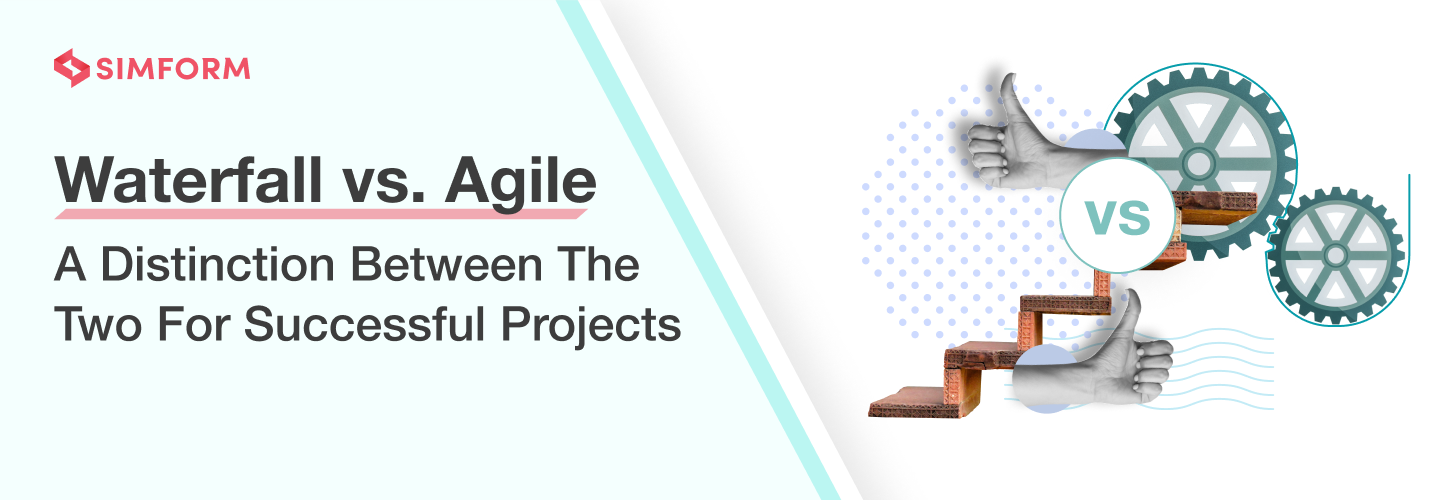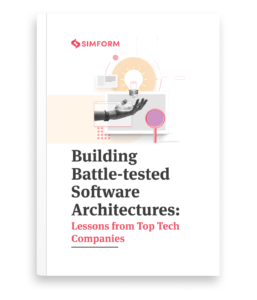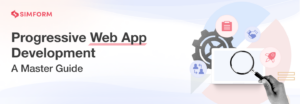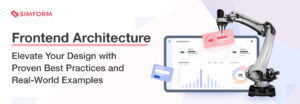Waterfall vs. Agile: A Distinction Between the two Methodologies
Spotify is a name hard to miss for people who love listening to music online. However, what makes Spotify the cornerstone for music streaming is its structure, based on Agile methodology. So, it’s not surprising that a Spotify model is pitched as an example while discussing the waterfall vs. agile comparison.
The Spotify model follows a structure of squads, tribes, and an agile coach. Each squad has 6-12 people working on features of a similar domain. Several squads together form a tribe. Further, an agile coach works similarly to a scrum master.
Such an agile approach helped Spotify improve time-to-market and cater to more than 422 million active monthly users. However, if you want to follow the Spotify model, an analysis of your requirements becomes essential. Every organization is different and has specific requirements for software development.
So, the approach you choose for software development needs to align with your requirement plan as they differ at each stage of the software development lifecycle. Here, we will discuss the differences between waterfall and agile methodologies.
Waterfall vs. agile: An Overview
Waterfall vs. agile is like a linear vs. simultaneous development flow comparison. The waterfall method follows a linear approach where the next phase of SDLC occurs after the predecessor phase is completed. On the other hand, agile follows a simultaneous flow, meaning each stage can be executed simultaneously.
Let’s understand both of these development approaches on a conceptual level.
Waterfall methodology

The waterfall model uses a sequence of stages that starts only after the predecessor stage is complete. It includes
- Requirements gathering stage involves the aggregation of project needs
- Design stage involves designing of software as per requirements
- Implementation stage involves the execution of software development process
- Verification stage includes approval of the build by QAs after testing of software
- Maintenance stage includes monitoring, tracking and improving the software performance.
The next stage begins only after the completion of the previous one. It is a sequential approach to software development, where a single disturbance in the sequence can disrupt the entire process. The designing phase in the waterfall approach follows a sequential design process. So, you must plan all the requirements because there is no flexibility to make sudden changes.
Benefits of waterfall methodology
- Advanced planning is a prerequisite for the waterfall approach, giving organizations complete visibility of the entire process beforehand.
- Fixed timeline of the waterfall approach makes it easier to manage the entire project.
- The scope and budget for waterfall software development are fixed, so there is no additional cost if you follow the plan.
- The design phase of the software development process is much more focused, with all the requirements integrated into the wireframe creation.
Limitations of waterfall methodology
- Hiring additional developers for new features for new features can be costly as you’d have to break the planned software development flow.
- The migration of technology for upgrades or additional features can be complex.
- Lack of flexibility in the process does not allow for sudden changes.
- Lower feedback integration due to a restricted approach with zero involvement by the client
Myths of waterfall methodology
- The waterfall method is a rigid approach and does not offer any flexibility.
- It needs absolute command and control.
- The testing phase occurs only after the completion of the coding process.
- The waterfall approach has minimal involvement of customers
- Every aspect of software development is executed in a strict phase scaling horizontally
- The design phase needs to be comprehensive and complete upfront.
These myths look more like an argument from an agile practitioner! However, the above myths can be burst by an alternate approach(not agile)- “Royce Waterfall Method.”
Dr. Winston. W. Royce, in 1970, provided an analysis of the waterfall approach by identifying the problematic patterns. So, the recommendations provided by him from the Royce Waterfall Methodology.
So, how is Royce waterfall different from the conventional waterfall approach?
The traditional approach is the “Frozen” version of the waterfall approach. On the contrary, Royce’s waterfall approach suggests
- Use of process control, planning, and documentation to reduce risks
- It focuses on the entire software development lifecycle by supporting stages like designing, developing, testing, and maintenance
- Each phase has two parts- execution and validation
- The validation process involves the client’s approval
- Splitting the steps in two also allows better control and quality assurance.
Agile Methodology

Agile methodology follows an incremental, iterative approach to software development. Each iteration involves creating a build, testing, deploying, and integrating feedback. With continuous integration of feedback on each incremental iteration, you continuously improve the end product.
The best part of the agile approach is how it leverages smaller but faster sprints for each SDLC stage. The agile approach breaks the entire process into smaller deliverable units. Agile allows you to leverage small sprints or timeboxes. Each of the sprints has specific tasks. After each task, there are assessments, and the feedback is integrated into the next iteration.
Benefits of agile methodology
- Superior software quality due to continuous integration of the feedback and testing.
- Better control of the project outcomes owing to continuous feedback integrations, transparency, and quality.
- Agile ensures that you have teams work across different feature development and have cross-domain experience.
- Support for CI/CD and DevOps practices enhances the software delivery enabling a seamless user experience.
- The flexibility of adding new features during the project execution without disrupting the operation
Limitations of agile methodology
- Lack of resource management makes it difficult to predict a project’s cost, infrastructure, and outcome.
- Minimal documentation means new developers will have a steep learning curve for process onboarding.
- Non-cohesive output is a common issue in agile projects as teams work on different services, and the outcome is fragmented.
- The difficulty of tracking the progress across software development cycles is due to the see-as-you-go characteristics of agile methodologies.
Myths of agile methodology
- Agile is scrum, and scrum is agile
- It does not need any documentation
- Agile means you don’t need to plan any software development stage
- It is timeboxed, so the completion timeframe for each stage needs to fit in
Agile methodology is not equal to Scrum –HOW?
Agile is a mindset and an umbrella of several methodologies. For example, scrum is one of the agile methodologies. Now that we know the crux of waterfall vs. agile differentiation let’s discuss how these methodologies differ at each stage of software development.
Requirements planning for waterfall and agile methodologies
The requirement and planning stage is key to the software development lifecycle. In the waterfall approach, you must have a requirement plan for the entire software development project. You will have to analyze the software development projects and define requirements for costs, resources, risks, etc.
On the other hand, the agile approach does not need definitive requirements. Therefore, the requirements and planning stage in the agile approach is not comprehensive.
So, how is this differentiation essential for your project?
Waterfall vs. agile methodology differentiation at the requirement stage is key to understanding which approach provides better flexibility. For example, if you use a waterfall approach, you must define the testing resources early. This becomes difficult for a project where you may need new features and test them on demand.
So, choosing a more flexible option like agile makes more sense. With each iteration, you can have a requirement plan which includes
- Feedback from earlier iterations
- Integration plan
- Timeframe for a task,
- Testing resources for the next iteration.
This means you can change the test resources after each iteration. As a result, it offers far more flexibility than the waterfall approach. If your project requirement plan is hard to predict, choose the agile approach.
MVP and full-fledged development: waterfall vs. agile
MVP or minimum viable product is a basic version of your software. It is the “shippable” product that users can experience, allowing you to improve the product. When it comes to MVP development, the waterfall approach is a good option for projects with well-defined requirements.
On the other hand, agile is best suited for MVP development for projects where time to market needs to be short. MVP kickstarts the software development stage, and here lies a key differentiation of waterfall vs. agile.
Software development in waterfall and agile methodology
Development in the conventional waterfall approach is based on requirements defined during the requirement analysis phase. In other words, you develop the code according to the specific needs defined through requirement analysis.
The waterfall model does not allow you to change any part of the software code unless the entire testing process is complete. Agile, on the other hand, uses an incremental approach. So, you can easily change a software code according to the scaling and functional needs.
Testing & deployment: waterfall vs. agile
Every software development project needs elaborate testing to ensure high-quality code and user experience. Therefore, testing comparison can’t be ignored if we compare waterfall vs. agile for software development.
Let’s have a head-on-head comparison,
| Waterfall testing | Agile testing |
| Testing phase is a separate phase in the model | Test phase is not a separate part and is included in the continuous improvement cycle. |
| You can execute tests only after the software code has been developed. | Agile allows parallel testing, where you can test while creating a software code. |
| User acceptance testing and regression tests are done after the completion of the project. | You can carry out UAT and regression testing with each iteration making it a more efficient option. |
| You have to plan for all the tests during the requirement planning stage. | You can design and plan tests after each cycle of building, testing, and deploying iterations. |
| Different testing levels like surface level tests and other in-depth levels can’t overlap | Surface level tests, and in-depth tests can overlap in agile. |
When it comes to the deployment of software releases, waterfall and agile have different ways of execution. The waterfall approach has a deployment process where you go all-in!
In other words, you need to deploy everything at once. It makes the entire process complex and bulky.
Agile approach enables deployment in small chunks, making it easier for teams to accommodate fixes and new changes. The way you can adjust deployment configurations for each iteration makes agile a more efficient approach.
Waterfall vs. agile: when to Use?
Comparing agile and waterfall methods for your software development needs consideration of several use cases.
Use cases of the waterfall method
You can use the waterfall approach when –
- Your software project has fixed requirements and does not need many changes
- You are developing software that needs to follow specific standards and compliance requirements
- You are developing software for clients with a fixed scope, budget, and timeline
- You have higher software expertise, and room for coding errors is minimal
- You are developing the software in one go and have technical expertise with enough resources available
Use cases of the agile method
You can use the agile approach when –
- You are developing an MVP and want to improve the application further with the addition of features
- You don’t have the technical expertise and may need to migrate to new technologies for new features
- You need constant feedback integration into your software development
- You are creating software that will need approvals from the client at each stage
- You are developing a real-time data analytics or data processing software
Agile software development is an approach that enables you to have better flexibility, scalability, and optimization. Here are some examples of agile methodology applications.
Examples of agile development
Agile development is synonymous with business agility! Customers’ demands change, and adapting to them is difficult without business agility. Agile methodologies enable businesses to adapt to customer behavior through rapid releases. It also cuts down the time needed for planning the software development process.
Uber reduced planning time and improved workflow focus with agile
Uber was struggling with planning, prioritization, and workflow issues. Specific tasks took too long to plan, while others lacked 40% of planning. The project team at Uber also lacked a task prioritization plan, leading to delayed software releases.
So, Uber adopted the agile approach and improved its workflow focus. Before agile, the operations team at Uber needed 8.8 hours per week for the planning stage, and managers spent more than 12 hours weekly. Agile helped Uber reduce the planning time to 5 hours for operations and managers.
Further, Uber improved the prioritization of tasks through EVR (Enterprise Visibility Room). It allowed them to have better visibility of each decision.
Barclays reduced code complexity and shortened deployment cycles with agile
Barclays is a massive enterprise with more than 130,000 employees and 800 teams.
Scaling across several internal teams and achieving organizational goals was a significant challenge.
So, Barclays chose to use Disciplined Agile(DA). It used the Scaled Agile Framework(SaFe) and Large Scale Scrum(LeSS) to implement the DA. SaFe allowed Barclays to define roles that cover specific concerns like architecture, Product Management, and release management.
On the other hand, LeSS provides the much-needed product owner hierarchy. In other words, LeSS enabled Barclays to define ownership of tasks for specific roles. Using the DA, Barclays managed to deploy within 0-4 weeks. In addition, it has reduced code complexity by 50% across 80 applications.
Etsy improved code update deployment rates with agile
Etsy, an online peer-to-peer marketplace for antiques, handmade jewelry, and other items, was facing the challenge of rapidly releasing an app and website features for millions of users. So, The eCommerce giant decided to use agile with DevOps to improve deployment time.
Etsy brought a new technical management team to adopt an agile approach and implement a DevOps culture. It helped them reduce the deployment time and have a code update every 20 minutes for their websites. Further, Etsy also improved collaboration between operations and the development team.
Simform: An agile expert at work!
So, who is the winner in the batter of waterfall vs. agile? Well, if you look at the pros, cons, use cases, and examples, agile might seem to be the winner. However, there are specific use cases where the waterfall approach is still a worthy choice. So, choosing agile or waterfall for your projects will depend on specific business requirements.
Simform has been at the forefront of providing engineering solutions using the agile methodology. For example, a freight management business needed to develop software with real-time tracking features. Engineers at Simform used agile methods and developed customized features. They ensured software’s feature accuracy and operational efficiency.
So, if you are looking for an agile software solution, sign up for a 30-minute free consultation session with our expert now!





